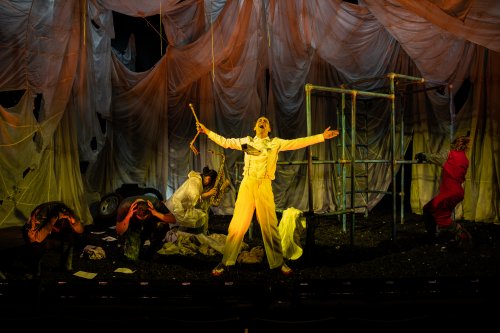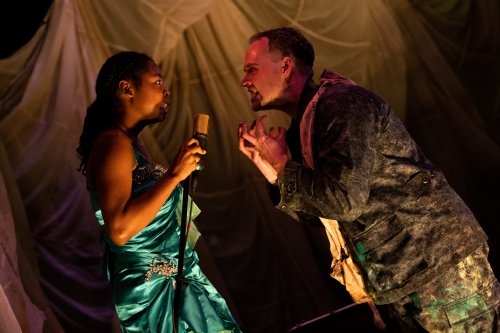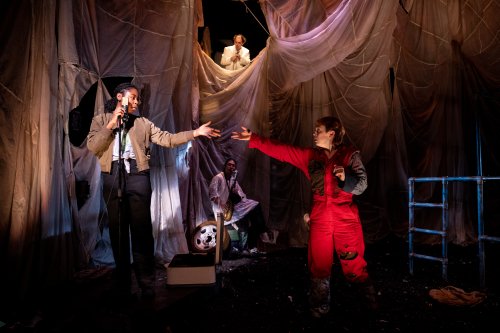GAS
An exploration into the never-never land of a war without end.

Ta’Neesha Murphy, JJ McGlone, Kevin Kim, A.J. Ditty and Scout Backus in a scene from Charles Cissel’s “GAS” at Theatre Row (Photo credit: Maria Baranova)
[avatar user=”Scotty Bennett” size=”96″ align=”left”] Scotty Bennett, Critic[/avatar]
George Santayana said, “Only the dead have seen the end of war.” War is a time of chaos and unreality, even within apparently well-organized military units. Survival requires more than the ability to navigate the immediacy of the conflict but to build the resources necessary to survive in the aftermath of the chaos. For some, nay, for many, the war never ends.
GAS by Charles Cissel explores the “never-never land” of a war without end. It is a time when the characters examine the unreality of the experience. It occurs within an ill-defined dimension resembling a bombed-out children’s playground. Felicia Lobo guides the able cast through what is, at times, a complicated, multilayered story that ultimately fails to deliver the nuances of the script engagingly.
In part, I believe that the failure to deliver the message clearly is a function of an inability to stage the play physically as written and a misinterpretation of the overall messages in the play. The script provides a clearer understanding of the playwright’s intent than the production’s. If you like experimental, somewhat abstract dramas, you may find GAS worth a visit, but otherwise, you may want to wait for a production that fully incorporates the set directions and staging from the script.
This four-character play starts in darkness, with a saxophone playing “Reveille,” accompanied by the sounds of explosions from bombs or cannons. The stage becomes bathed in red light as the saxophone flows into Country Joe and the Fish’s song “What Are We Fighting For,” and then transitions into a screeching sound as the first character, the Fool (Scout Backus), emerges from a large pipe at the side of the stage. They are unclear about how they came to this space after being killed in the war. They speaks of their search for pieces of their heart that were blasted away. The scene ends as the Fool exits bathed in a red light.

Ta’Neesha Murphy and JJ McGlone in a scene from Charles Cissel’s “GAS” at Theatre Row (Photo credit: Maria Baranova)
The next scene opens with a character dressed in white, high above the stage, who calls himself Godme and declares himself to be a man-made god. He is played by A.J. Ditty, giving the best performance in the show, not only for the strength of his characterization but also the nature of the text he delivers. In Godme’s view, he is either the war’s creator or the war’s creation. However, he is unclear on which is accurate, and neither is the audience. This lack of definition is a theme that runs through the production with an apparent nod to Samuel Beckett and his familiar but oblique theme of the passage of time.
Shortly after the appearance of Godme, Marlene (Ta’Neesha Murphy), a young woman with no clear definition, enters. Her lines are spoken in a mix with the words of Godme, hinting at who she may have been in her life. She is looking for medals in a suitcase, and then bathed in a spotlight, she sings “Dream A Little Dream of Me” into a microphone as if she were a club performer. The scene fades to black with a hissing sound coming from the saxophone.
The fourth and final character arises when a blue light appears on Marlene. Otto (JJ McGone), who has been on the stage from the opening curtain but only becomes animated as Marlene begins to sing “Sag Mir Wo Die Blumen Sind,” the German translation of “Where Have All the Flowers Gone” that was recorded by Marlene Dietrich in 1963. He is the only character that is living. He can’t see Marlene, but he can hear her. They have a discussion on the nature of war.
The play moves between the characters’ conversations on the nature of life and death in the context of a never-ending war. Unfortunately, the discussions do not lend themselves to understanding the absurdity of war or the futility of conflict. The actors work hard at making sense of the script, but they do not achieve that end except for Ditty.

Ta’Neesha Murphy, A.J. Ditty(above), Kevin Kim (below) and Scout Backus in a scene from Charles Cissel’s “GAS” at Theatre Row (Photo credit: Maria Baranova)
It is important to note that the show uses music and sounds from a saxophone, expertly provided by Kevin Kim, to deliver subtle commentary before and after various actions. Kim’s playing is very much a character in the production; however, the songs and sound effects are not readily apparent in the efforts being played out. For example, as stated above, the opening music and sound effects make sense only in reflection after the story has unfolded.
Other uses are subtle or overshadowed by the dialogue of the characters. When Marlene is softly singing “Dream A Little Dream of Me,” it is not clear that the song relates to the dialogue being spoken by Ditty as Godme. The Marlene Dietrich version of “Where Have All the Flowers Gone” is meaningless unless one picks up clearly on the melody being played and then figures out the reason for the German version of the song.
The scenic design by Christopher and Justin Swader effectively conveys, in a limited space, a vision of a landscape devastated by war. However, the use of torn parachutes as the container for the landscape is less successful. The sound design by Matt Keim delivers the changes in tone and resonance for both the music and dialogue as needed in the story, with only a few glitches in volume. Elizabeth M. Stewart’s lighting design works well in support of the action. The costume design by Katja Andreiev and the prop design by Patricia Marjorie are well executed.
GAS (through June 10, 2023)
Presented by Luke Wilson
Theatre Four at Theatre Row, 410 West 42nd Street, in Manhattan
For tickets, visit http://www.theatrerow.org
Running time: 80 minutes without an intermission






Leave a comment